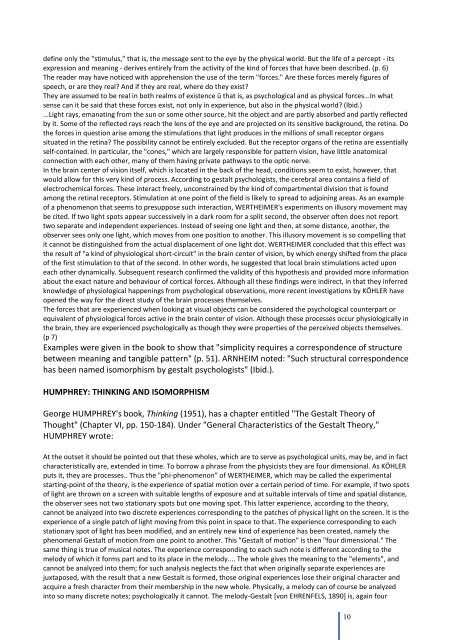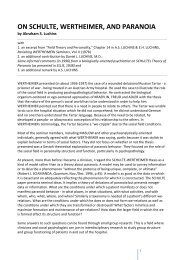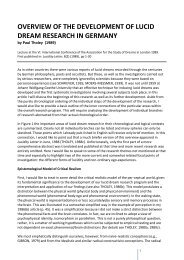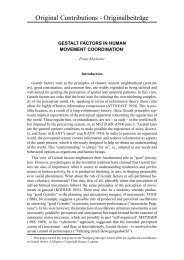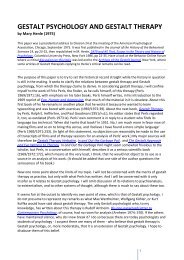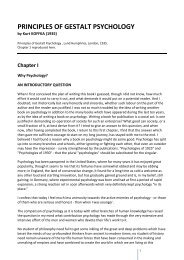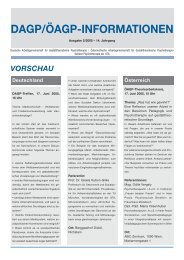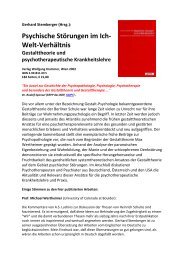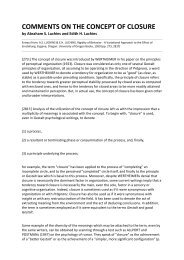pdf-Download - Society for Gestalt Theory and its Applications (GTA)
pdf-Download - Society for Gestalt Theory and its Applications (GTA)
pdf-Download - Society for Gestalt Theory and its Applications (GTA)
Create successful ePaper yourself
Turn your PDF publications into a flip-book with our unique Google optimized e-Paper software.
define only the "stimulus," that is, the message sent to the eye by the physical world. But the life of a percept - <strong>its</strong>expression <strong>and</strong> meaning - derives entirely from the activity of the kind of <strong>for</strong>ces that have been described. (p. 6)The reader may have noticed with apprehension the use of the term "<strong>for</strong>ces." Are these <strong>for</strong>ces merely figures ofspeech, or are they real? And if they are real, where do they exist?They are assumed to be real in both realms of existence û that is, as psychological <strong>and</strong> as physical <strong>for</strong>ces...In whatsense can it be said that these <strong>for</strong>ces exist, not only in experience, but also in the physical world? (Ibid.)...Light rays, emanating from the sun or some other source, hit the object <strong>and</strong> are partly absorbed <strong>and</strong> partly reflectedby it. Some of the reflected rays reach the lens of the eye <strong>and</strong> are projected on <strong>its</strong> sensitive background, the retina. Dothe <strong>for</strong>ces in question arise among the stimulations that light produces in the millions of small receptor organssituated in the retina? The possibility cannot be entirely excluded. But the receptor organs of the retina are essentiallyself-contained. In particular, the "cones," which are largely responsible <strong>for</strong> pattern vision, have little anatomicalconnection with each other, many of them having private pathways to the optic nerve.In the brain center of vision <strong>its</strong>elf, which is located in the back of the head, conditions seem to exist, however, thatwould allow <strong>for</strong> this very kind of process. According to gestalt psychologists, the cerebral area contains a field ofelectrochemical <strong>for</strong>ces. These interact freely, unconstrained by the kind of compartmental division that is foundamong the retinal receptors. Stimulation at one point of the field is likely to spread to adjoining areas. As an exampleof a phenomenon that seems to presuppose such interaction, WERTHEIMER's experiments on illusory movement maybe cited. If two light spots appear successively in a dark room <strong>for</strong> a split second, the observer often does not reporttwo separate <strong>and</strong> independent experiences. Instead of seeing one light <strong>and</strong> then, at some distance, another, theobserver sees only one light, which moves from one position to another. This illusory movement is so compelling thatit cannot be distinguished from the actual displacement of one light dot. WERTHEIMER concluded that this effect wasthe result of "a kind of physiological short-circuit" in the brain center of vision, by which energy shifted from the placeof the first stimulation to that of the second. In other words, he suggested that local brain stimulations acted uponeach other dynamically. Subsequent research confirmed the validity of this hypothesis <strong>and</strong> provided more in<strong>for</strong>mationabout the exact nature <strong>and</strong> behaviour of cortical <strong>for</strong>ces. Although all these findings were indirect, in that they inferredknowledge of physiological happenings from psychological observations, more recent investigations by KÖHLER haveopened the way <strong>for</strong> the direct study of the brain processes themselves.The <strong>for</strong>ces that are experienced when looking at visual objects can be considered the psychological counterpart orequivalent of physiological <strong>for</strong>ces active in the brain center of vision. Although these processes occur physiologically inthe brain, they are experienced psychologically as though they were properties of the perceived objects themselves.(p 7)Examples were given in the book to show that "simplicity requires a correspondence of structurebetween meaning <strong>and</strong> tangible pattern" (p. 51). ARNHEIM noted: "Such structural correspondencehas been named isomorphism by gestalt psychologists" (Ibid.).HUMPHREY: THINKING AND ISOMORPHISMGeorge HUMPHREY's book, Thinking (1951), has a chapter entitled "The <strong>Gestalt</strong> <strong>Theory</strong> ofThought" (Chapter VI, pp. 150-184). Under "General Characteristics of the <strong>Gestalt</strong> <strong>Theory</strong>,"HUMPHREY wrote:At the outset it should be pointed out that these wholes, which are to serve as psychological un<strong>its</strong>, may be, <strong>and</strong> in factcharacteristically are, extended in time. To borrow a phrase from the physicists they are four dimensional. As KÖHLERputs it, they are processes.. Thus the "phi-phenomenon" of WERTHEIMER, which may be called the experimentalstarting-point of the theory, is the experience of spatial motion over a certain period of time. For example, if two spotsof light are thrown on a screen with suitable lengths of exposure <strong>and</strong> at suitable intervals of time <strong>and</strong> spatial distance,the observer sees not two stationary spots but one moving spot. This latter experience, according to the theory,cannot be analyzed into two discrete experiences corresponding to the patches of physical light on the screen. It is theexperience of a single patch of light moving from this point in space to that. The experience corresponding to eachstationary spot of light has been modified, <strong>and</strong> an entirely new kind of experience has been created, namely thephenomenal <strong>Gestalt</strong> of motion from one point to another. This "<strong>Gestalt</strong> of motion" is then "four dimensional." Thesame thing is true of musical notes. The experience corresponding to each such note is different according to themelody of which it <strong>for</strong>ms part <strong>and</strong> to <strong>its</strong> place in the melody.... The whole gives the meaning to the "elements", <strong>and</strong>cannot be analyzed into them; <strong>for</strong> such analysis neglects the fact that when originally separate experiences arejuxtaposed, with the result that a new <strong>Gestalt</strong> is <strong>for</strong>med, those original experiences lose their original character <strong>and</strong>acquire a fresh character from their membership in the new whole. Physically, a melody can of course be analyzedinto so many discrete notes; psychologically it cannot. The melody-<strong>Gestalt</strong> [von EHRENFELS, 1890] is, again four10


